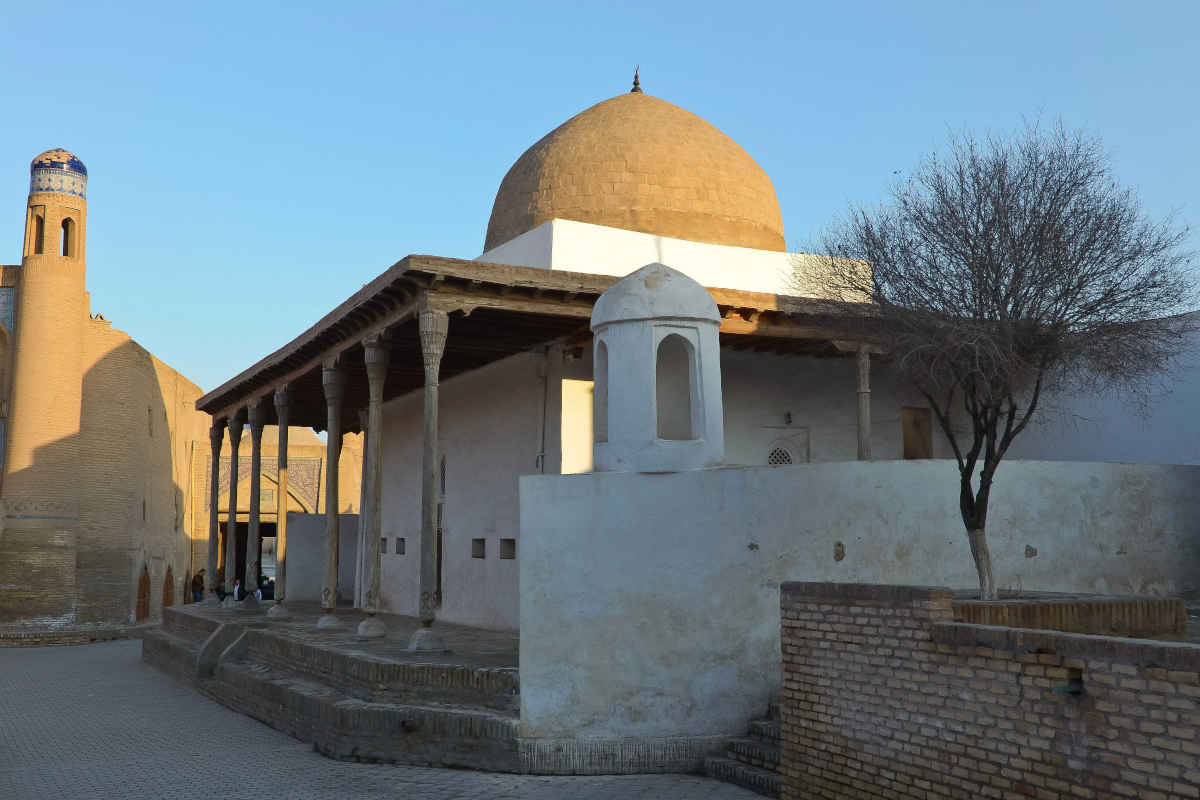Khiva - Ak Mosque

The Ak Mosque of Khiva: an architectural jewel of Central Asia
The Ak Mosque, also known as the ‘White Mosque’, is located at the eastern gate of the historic centre of Ichan-Qala in Khiva, one of the most important cities in Uzbekistan. This small but architecturally valuable building is a so-called ‘neighbourhood mosque’ (mahalla or guzar mosque), a type of building that was erected specifically for the residents of a particular district. These mosques not only served as places of prayer, but also as social centres where the neighbourhood gathered and discussed important matters of everyday life.
Historical background
The original construction of the Ak Mosque dates back to the 17th century, when it was built during the reign of Anush Khan. In its present form, however, it dates back to an extensive renovation carried out between 1838 and 1842. Despite its modest size, the mosque is a remarkable example of the traditional architecture of the region, which flourished in the late period of the Khanate of Khiva. Its architecture combines simple elegance with functional practicality and impressively demonstrates the master craftsmanship of the time.
Architectural specialities
The centrepiece of the Ak Mosque is the central domed chamber, the so-called Khanaqa, which has a floor area of 6.25 × 6.35 metres. This chamber is surrounded on three sides by high, multi-columned aiwans. These open, shady galleries not only served as prayer rooms, but also offered worshippers protection from the intense sunlight. The aiwans and the khanaqa contain artistically designed mihrab niches that mark the direction of prayer towards Mecca.
The masterful wood carving, which is reflected in the intricately decorated wooden columns of the mosque, is particularly noteworthy. These columns are erected on ornate plinths and decorated with detailed floral and geometric ornaments. The precision and elegance of the carvings testify to the high level of craftsmanship of the 19th century artisans. The names of two outstanding masters, Usta Nurmuhammad and Usta Qalandar, are immortalised on the elaborately decorated mosque doors, which are richly ornamented.
Another architectural highlight is the white gantsch coating on the walls, which not only gave the mosque its name, but also lends it an almost luminous, sublime appearance. It is assumed that this name comes from a predecessor building that already existed under Anush Khan. Archaeological investigations suggest that there are still remains of this earlier structure under the current walls.
The function of the mosque in society
In addition to its religious function, the Ak Mosque had a central social significance for the residents of the surrounding neighbourhood. As a neighbourhood mosque, it not only served as a place of prayer, but also as a meeting place for important community events. Social issues were discussed here, weddings were planned and religious festivals were organised. Such mahalla mosques were of central importance to the social fabric of the city and played a crucial role in the lives of its inhabitants.
Art historical significance
The ornate design of the Ak Mosque makes it an outstanding example of Central Asian architecture. Particularly noteworthy are the finely crafted door closures and the openwork wooden window grilles, which have a decorative value in addition to their functional significance. The ornate inscriptions concealed in the carvings on the doors are not only evidence of fine craftsmanship, but also provide an insight into the religious and cultural world of the time.
The main prayer room of the mosque is located in a separate winter building, which is crowned by a striking white dome. This architectural element not only fulfils an aesthetic function, but also serves to regulate the climate by storing heat and thus enabling the mosque to be used during the cold winter months.
The Ak Mosque in Khiva is much more than just a religious building. It is an important testimony to Islamic architecture in Central Asia and an impressive example of the region’s master craftsmanship. Its detailed woodcarving, architectural clarity and social significance make it an indispensable part of Khiva’s cultural heritage. Visitors to the historic centre of Ichan-Qala should not miss out on exploring this remarkable building and experiencing the special atmosphere of this place.
